I kind of love these.
Here’s a thorough, 10-minute tutorial.
And here’s his webpage with lots more info about his daily monsters projects: Stefan G. Bucher’s Daily Monsters Project.
by Aisling D'Art
Drawing, sketching, and painting tips, especially for your art journal or diary, “morning pages,” sketchcrawls, travel journals, and more.
I kind of love these.
Here’s a thorough, 10-minute tutorial.
And here’s his webpage with lots more info about his daily monsters projects: Stefan G. Bucher’s Daily Monsters Project.
Are you looking for drawing and painting ideas? Want to know what to draw in your art journal?
Here’s one very cute approach to art. Thanks to Jane Davenport, it can be easy, too.
Jane Davenport has inspired many people to create elegant and charming illustrations in their art journals. She’s made this easy with how-to books, as well as innovative art supplies.
Here’s her story, in her own words.
I bought one of her books, Beautiful Faces, because I felt like I was getting into a rut with my usual illustration techniques. (Generally, no one is likely to call my journals “cute,” but sometimes I’m aiming for pretty… and needed some insights. Jane’s book definitely helped.)
It’s just one of Jane’s many books you’ll find at Amazon.
Next, in this demo, she shows how to use her die-cut embellishments.
Notice the art she’s starting with. It includes “mark making,” stencils, sketches, and more.
Also, her art journaling examples suggest great layering techniques for art journaling. (I might use them in some Goth- and Steampunk-style art journals, too. Purples, metallics, and so on…)
Next, here’s Tamara Laporte (Willowing Arts) demonstrating some of Jane’s art supplies.
She starts with a blank page, then sketches in pencil, and then… well, you’ll see. (I’ve started the video at the 23-minute point. If you want to see the full unboxing, start from the beginning.)
If you like Tamara’s approach, take a look at the sample projects on her “Create Your Life” book page at Amazon.
Those ideas may be all you need to start experimenting with new drawing, painting, and mixed-media techniques, right away.
But, no matter what your art journaling style, when you’re deciding what to draw – especially in your art journals – I think you’ll find those videos (and products) inspiring.
Personally, I’m experimenting with magazine photos, pasting them (with Yes!Paste) onto a painted page, sealing them with gel medium, and then drawing & painting over them.
This involves layers. (If I’m going to use lots of layers or thick paint, I’ll prime the page with gesso, first.)
My art journaling isn’t necessarily sweet or romantic, but these techniques & materials can work for both “cute” and extreme artists’ journals, too.
Maps, cityscapes, landscapes… they’re not just for travel journals.
There are many ways you can include them in your personal art journals, too.
First, here’s Brie Hatton demonstrating urban sketching in her art journal. For many people, this is the easiest way to draw and paint local scenery in a journal. You can go for a walk, or sketch what’s outside your window.
The full video is about six minutes long, but I’ve set this to start at the four-minute mark. At that point, she’s done a light pencil sketch and has started using a marker over it, for her final lines. That’s what interested me the most: how she completed her sketch as a finished art journaling page.
Full video link: https://youtu.be/EfzEjku3ev8
The pen she’s using for the final, darker lines is a special Sailor Fude pen you can find at Amazon.
![]() Maybe drawing isn’t what you had in mind, but you’re still intrigued by landscapes.
Maybe drawing isn’t what you had in mind, but you’re still intrigued by landscapes.
If you’d like to create fine art abstract landscapes in your artists journal, I think Cathy Mevik’s demo will inspire you. If you’re not a painter, don’t let this scare you; I think anyone can create landscapes like these.
The video a little over 11 minutes long, but – for those who’d love to paint like this – it’s time well spent.
Video URL: https://youtu.be/HCYfAHVePMo
![]()
At the other extreme, here’s what James Gulliver Hancock draws. It’s a two-minute video, and he explains why he draws buildings, and what he learns as he draws them.
Video URL: https://youtu.be/360r-iyK_Eg
![]() Also, I kind of love that one of his books – with buildings and maps – became an interactive exhibit. This half-minute video is worth seeing:
Also, I kind of love that one of his books – with buildings and maps – became an interactive exhibit. This half-minute video is worth seeing:
Video URL: https://youtu.be/DwETY_OK86w
![]() If you’d like to explore making maps, this book looks fascinating. As soon as I saw this review video, I ordered the book. (The video is eight minutes long, but you’ll get the general idea in the first two or three minutes.)
If you’d like to explore making maps, this book looks fascinating. As soon as I saw this review video, I ordered the book. (The video is eight minutes long, but you’ll get the general idea in the first two or three minutes.)
Video URL: https://youtu.be/eKVdfRl05S0
I thought it was okay, but I’ll admit it didn’t inspire me as much as I’d hoped. Here’s the Amazon link, anyway. Use the “look inside” to decide if it’s your kind of book: The Art of Map Illustration
![]() If drawing and painting aren’t your strong suit, don’t despair. You can still bring maps and architectural designs to your journaling.
If drawing and painting aren’t your strong suit, don’t despair. You can still bring maps and architectural designs to your journaling.
Here’s a landscape-y, map-y kind of art journaling demo. It’s by Carolyn Dube, and she uses a stencil, some acrylic paint, and a pen. The video is about four minutes long, and – once you get the idea – you can fast-forward through it to see how she completes it.
Video URL: https://youtu.be/ZUXK1HkFhiI
The stencil is by Maria McGuire for StencilGirl, and you can find a similar stencil by her – and other StencilGirl artists – at Amazon.
![]()
And finally, for oh-my-goodness inspiration…
At first, Blythe Scott’s work may look like modern landscapes but, close-up, you’ll see mixed media elements. She’s using some materials that never crossed my mind, and they could go into a mixed media artists journals, too.
This five-minute video includes breathtaking outdoor scenes, how her art is inspired, and some great insights about studio work, using drawing, painting, and mixed media elements.
https://youtu.be/p5_oOuzpAUQ
![]()
This 12-minute video is from Danny Gregory’s Sketchbook Club, showing the progress of “Moonlight Chronicles” art with Dan Price. I think it’s a wonderfully inspiring example of how you can share your art journaling with others.
https://youtu.be/B_J3Re04cHg
![]() Here’s a 35-minute video showing where Dan Price lives and works, in an underground, kind of Hobbit-ish home.
Here’s a 35-minute video showing where Dan Price lives and works, in an underground, kind of Hobbit-ish home.
Need a quick jolt of inspiration for your art journaling? These brief videos can help… a lot!
Danny Gregory is an icon of art journaling. His artists journals were among the first to go viral, starting with his art journaling website and his books, including The Creative License – Giving Yourself Permission to Be the Artist You Truly Are.
Danny’s art is diverse. Watching these videos, I was inspired to break out my pens & paints, and start randomly journaling my day.
![]()
Here’s a brief (less than one-minute) video noting how drawing makes you see better. I like that he’s not super-finicky about things being perfect. Everything is suggested, and gives you a sense of what he’s drawing. It’s not intended to mimic a photograph.
https://youtu.be/csHRD6eHYcw
![]()
A five-minute video about journaling your breakfast…
https://youtu.be/KPYmVBTrpK0
And – also from Danny Gregory’s YouTube channel, here’s a brilliant, short video about learning to watercolor in three minutes. This demo is by Felix Scheinberger and I picked up some really useful tips. (I’m not so sure about using a lighter to dry the art faster, but – other than that – I’m ready to try some of his ideas.)
https://youtu.be/KJGwANFqaYc
If you’d like to see how Danny Gregory uses pencil + watercolor in a journal – following Felix’s tips – the last couple of minutes of this next video add more insights about this technique. That’s why it starts around the 3:56 mark.
(The full video is worth your time, but I’m mindful of friends who want to get to the art instruction, ASAP. So, if you want more insights, just pause that video & start it from the very beginning.)
https://youtu.be/mBW2Gxgdgm0?t=236
The good news is, the next announced sketchcrawl is October 16th. (See my notes from my July 2009 sketchcrawl.)
Right now, I’m on the fence. The email I rec’d from SketchCrawl.com was very different from the fun, wide-open, no-rules announcements of the past.
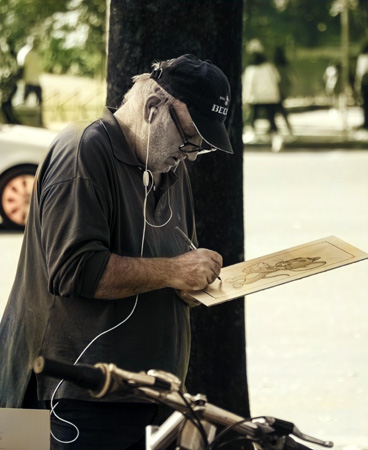 First, there was this message from that site:
First, there was this message from that site:
– A key thing, help us spread the word!
If you are reading this, we are sure you have a number of friends that might be interested in this as much as you are. Tell them about SketchCrawl! Let’s share this idea with the rest of the globe. No borders.
“No borders.” I like that reminder. The idea of a global, art-based event always delights me.
So, I was in a happy mood, already thinking about where I’d like to organize a sketchcrawl in October.
Then, I reached the list of rules that weren’t on previous SketchCrawl announcements. Here they are, cut-and-pasted from the email.
When you participate, please remember to:
-Notify us of any sketchcrawl events (as applicable)
-Link back to sketchcrawl.com
-Give credit to Enrico Casarosa as the founder
-Must be a non-profit event
-Include sketches in sketchcrawl.com/forums and Flickr pool (as applicable)
-Try and time your sketchcrawls with the World Wide dates we promote at sketchcrawl.com
Those sound reasonable enough, individually, but — in combination — they seem like corporate rules. That seems a little hinky. (Hinky = strange or suspicious.)
I did a quick check.
So far in 2010, the U.S. Trademark Database doesn’t show anything when I search for “sketchcrawl. So, as of 2010, the term “sketchcrawl” is still free to use without trademark-related restrictions.
![]()
2023 UPDATE: As of January 2023, at the Sketchcrawl (dot com) site, the “TM” with the name suggests they did trademark it. (Adding a copyright symbol next to that? That’s odd, since the term has been in use for a very long time. He can copyright the site but not the word “sketchcrawl.”)
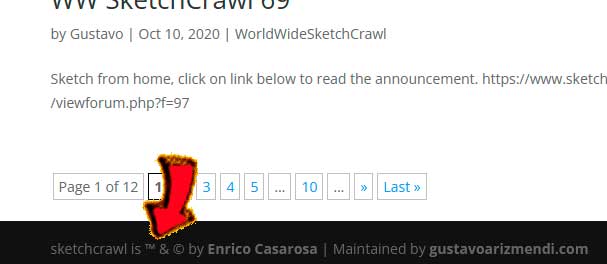
On one hand, I understand the importance of claiming a word or phrase that’s unique to your business. I’ve failed to do that (repeatedly) with my own projects. That’s been an expensive and disappointing series of blunders.
However, when I did a quick search to see if the Sketchcrawl (dot com) claim was legitimate, the results were interesting.
Here’s my search on 25 Jan 2023:
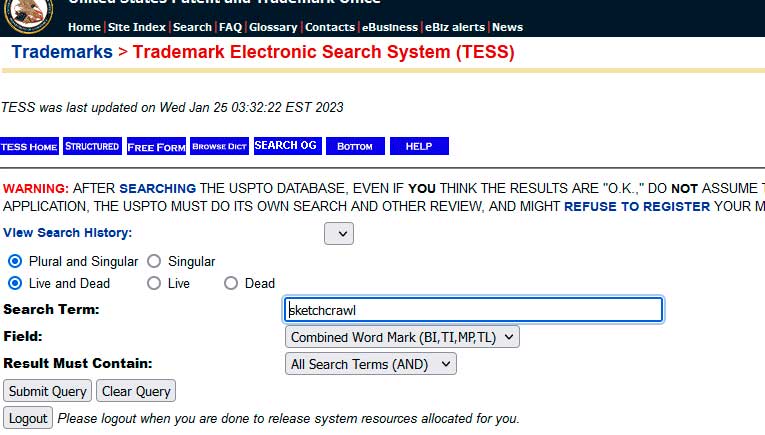
And here are the results of that search:

So, that suggests the “TM” indication is in error on the Sketchcrawl (dot com) site.
Hmm…
I’m relieved and a bit baffled.
On one hand, I never want a popular word trademarked. That goes double for a word already in popular use in the arts community.
I don’t like seeing people staking claims, trying to make money off things that were initially created to be free, fun and cool.
But why would someone suggest that they’ve trademarked a term when they haven’t? That’s very weird.
Maybe he doesn’t understand how copyright and trademarks work?
I’d like some clarification. After all, for at least a dozen years, this has been a concern for some of us.
For now, I may organize my own sketchcrawls, as I did in the past. However, I’m uneasy posting them on the Sketchcrawl site.
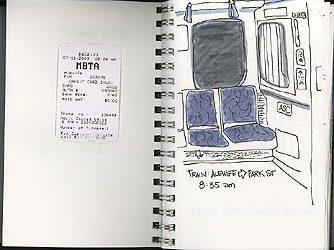
A sketchcrawl is a full-day of sketching or drawing in a journal, or on some other art materials such as paper, canvas, etc.
It’s usually part of a stroll, alone or with a group, looking at scenery at or near a specific destination.
It’s best to use whatever sketching supplies you’re most comfortable with. They should be light and portable.
Be sure you can use then while standing, with no other support to lean against.
Here’s what I carry with me:
A small notebook or sketchpad as a journal.
Suggested: US Art Supply’s 5.5″ x 8.5″ set of sketchbooks. The covers provide good support for sketching while standing up
A pen or pencil, for drawing lines.
Suggested: Any everyday pencil, if you’re planning simple line drawings. I like an HB (lead firmness) pencil, or a standard 2B school-type pencil. If you’re going to do shaded sketches entirely in pencil, it’s good to use a set of pencils. Amazon Basics’ set is pretty good and includes erasers and sharpeners.
My favorite pen for drawing lines is Sakura’s Pigma Micron, with an 08 tip. It’s waterproof, so I can use watercolors or felt coloring pens over it, almost immediately.
An eraser, if you’re sketching with a pencil.
Suggested: I carry both a kneaded rubber eraser and a standard drafting-style eraser. (Both are in the Amazon Basics set.)
Something to add color, like watercolors (and water, and a brush), or colored pens or pencils.
Suggested: The Sakura Koi set of watercolors is very good. If you’re going to use colored pencils, Sargent makes a good, portable set. But, you may want to try something unusual, like a Petallush pencil. (Note: I haven’t tried them for sketchcrawls, yet.
Tape, to fasten ephemera in your art journal.
Suggested: I’d use a temporary tape, like blue painter’s tape in a narrow width. Then I’d use glue or something more permanent once I returned home. (Then I can decide the best position, angle, or page for whatever the ephemera is.)
Snacks, in case you get hungry.
Suggested: Carry both a protein-rich snack (like a protein bar for sustained energy) and something sugary (for a quick, late-in-the-day burst of energy).
Optional: A camera (you can use your phone), in case you want to add printed photos to your journal, later.
In general, I suggest keeping your art supplies simple and as light (and perhaps small) as possible.
The most essential item will be your sketchpad or journal. Be sure you can lean on it and sketch without other support.
Can’t find the perfect watercolor set? Here are some ideas for making your own mini-watercolor palette:
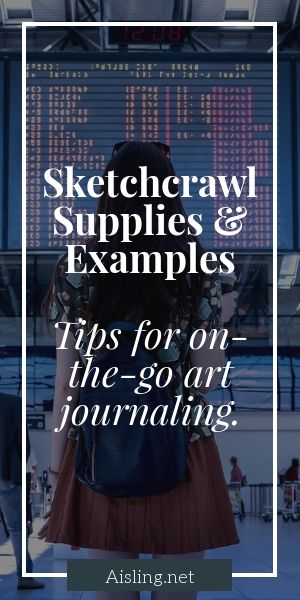 Your sketchcrawl journal (or sketches) will look like whatever YOU decide.
Your sketchcrawl journal (or sketches) will look like whatever YOU decide.
There are no rules.
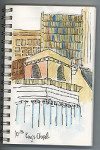 Would you like to see an example?
Would you like to see an example?
In July 2009, I took part in a sketchcrawl around Boston’s Freedom Trail. (You can see some of those sketches and photos at Sketchcrawl Notes – July 2009.)
Sketchcrawls are great practice for creating travel journals, too. The materials & techniques are the same.
See if you enjoy it!
You can go on your first sketchcrawl right now.
You could try a sketchcrawl somewhere near your home, even in your backyard.
Then, try a few more sketchcrawls, on your own or with friends.
It’s okay to organize your own sketchcrawls. This has always been a very fun, informal way to create art as you explore cool and interesting locations.
Online, you may find sketchcrawl announcements, too.*
You can follow me at Facebook (as “Aisling Creates”) for my sketchcrawl plans, and other artsy news.
You can use those same sketchcrawl supplies — carried in your purse or backpack — when you travel. Whether it’s a daytrip, a road trip, a holiday, or a vacation, sketching can provide you with wonderful keepsakes when you get home.
(Traveling on a plane? remember some airlines’ four-ounce rule on liquids… no big containers of gel medium, glue, or tubes of paint.)
For me, sketching – with pencil, pen, markers, or watercolors – is a relaxing way to enjoy the scenery, wherever I am. Whether it’s a local scene or a trip abroad, art journaling helps me notice — and appreciate — more of what’s around me.
*Note: The sketchcrawl (dot com) site is one place you’ll find sketchcrawls announced.
However, that site’s owner claims that the term “sketchcrawl” is trademarked. Umm… no. Checking the trademark registry regularly, I still don’t see sketchcrawl registered as a trademark.
I’m not sure it can be trademarked (or copyrighted) since the term has been in use for decades, or perhaps longer. Not unless it’s connected with a very specific project, and only for that particular use. (For example, “ghost hunters” couldn’t be trademarked, but it could be licensed, just for the TV series.)
So, I’m reluctant to recommend that sketchcrawl website.